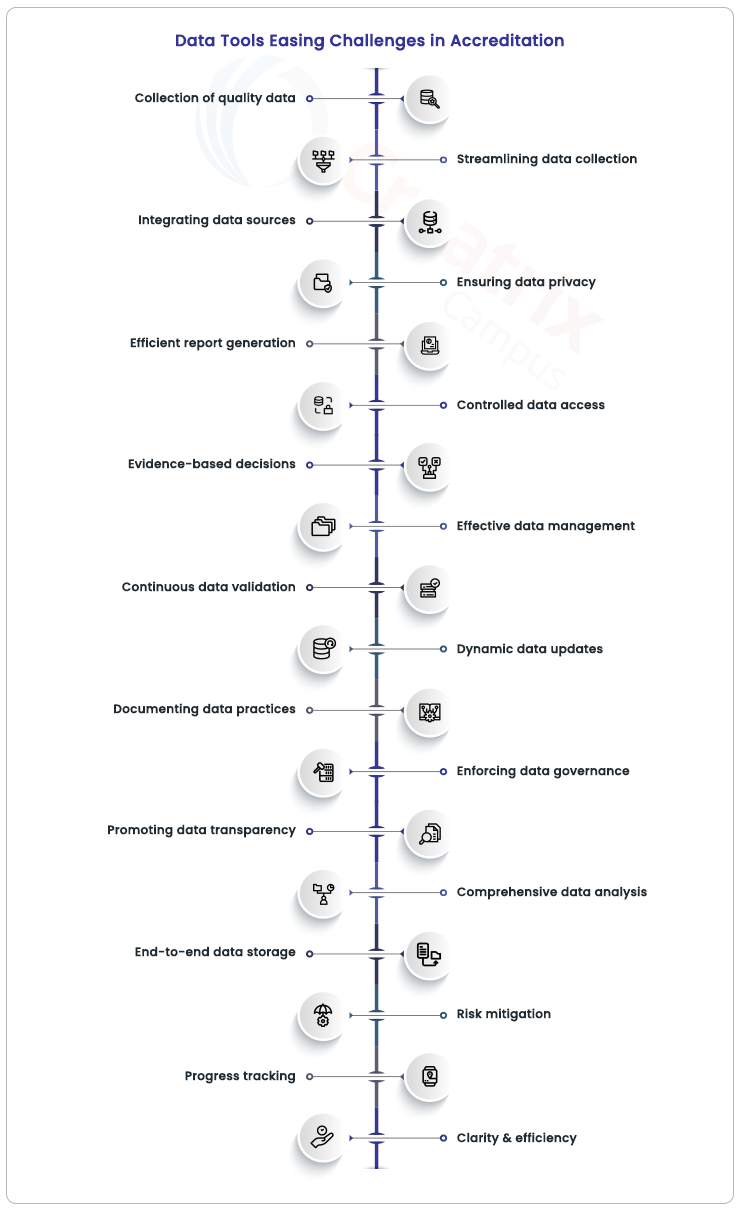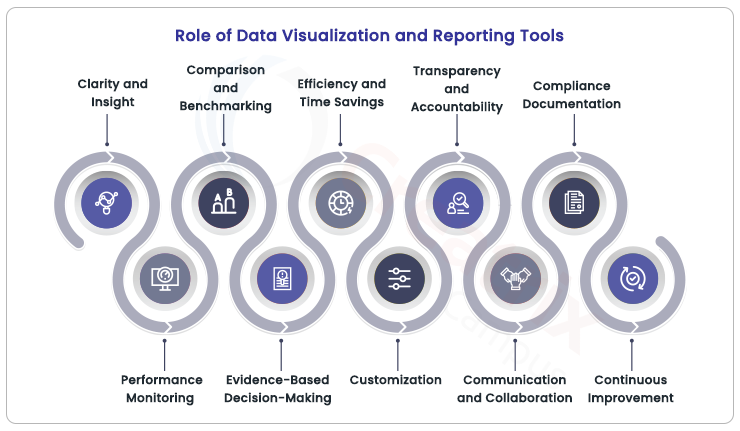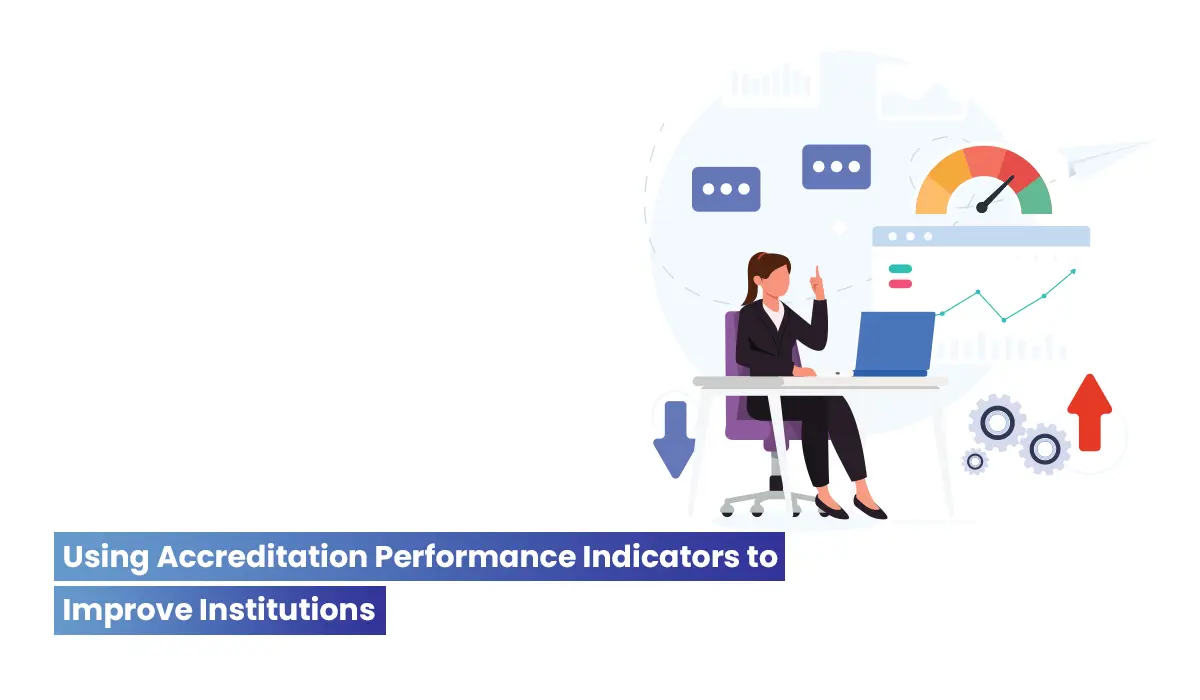Visualizing Success: How Data Reporting Tools Simplify Academic Accreditation

As top colleges and universities continue to dominate the higher education industry with high-quality programs, a greater number of institutions are realizing the potential of getting their course accredited and adopting the continuous quality improvement process from admission to graduation. Not only can this help educational institutions with a unique opportunity to provide quality programs and courses to students, but it also represents a tremendous opportunity for educators to drive enrollment and improve program ranking globally.
What is higher education accreditation?
Higher education accreditation is a formal evaluation process for colleges and universities to ensure they meet quality standards. It's granted by accrediting agencies and comes in two types: institutional (evaluating the whole institution) and programmatic (evaluating specific programs). Accredited institutions enjoy benefits like credibility, eligibility for funding, and better employability. Continuous monitoring ensures quality, while loss of accreditation can have serious consequences. Students should check an institution's accreditation status before enrolling to ensure quality education.
Common data-related Accreditation problems faced by Institutions

Data Quality: Ensuring the accuracy, completeness, and consistency of data used for accreditation can be challenging.
Data Collection: Gathering comprehensive and relevant data from various sources can be time-consuming and resource-intensive.
Data Integration: Integrating data from disparate systems and sources to create a unified view for accreditation purposes can be complex.
Data Security: Safeguarding sensitive accreditation-related data and ensuring compliance with data privacy regulations is crucial.
Data Reporting: Generating accurate and meaningful reports that meet accreditation requirements can be a daunting task.
Data Accessibility: Providing authorized stakeholders with access to necessary data for accreditation purposes can be challenging while maintaining data security.
Data Analysis: Analyzing data effectively to derive insights and evidence for compliance can be demanding.
Data Storage: Managing the storage and retention of accreditation-related data can become overwhelming, especially for long-term compliance tracking.
Data Validation: Ensuring that the data provided aligns with accreditation standards and criteria can be a continuous validation process.
Data Updates: Keeping data up-to-date and relevant to meet changing accreditation requirements can pose challenges.
Data Documentation: Maintaining comprehensive documentation of data sources, processes, and methodologies used for accreditation reporting is essential but can be cumbersome.
Data Governance: Establishing clear data governance policies and practices to maintain data quality and integrity is often a complex task.
Data Transparency: Ensuring transparency in data collection, reporting, and usage for accreditation purposes is vital but can be difficult to achieve.
How data visualization and reporting tools help overcome these challenges?

Collection of quality data: Visualization tools provide clear insights into data discrepancies, helping institutions identify and rectify data quality issues. Reporting tools can generate data quality reports for ongoing improvement.
Streamlining data collection: These tools can streamline data collection processes, automate data inputs, and centralize data sources, reducing the effort required for data gathering.
Integrating data sources: Data visualization and reporting tools often offer integration capabilities, allowing institutions to aggregate data from various sources into a unified view for accreditation purposes.
Ensuring data privacy: Accreditation software with data visualization and reporting features prioritizes data security, ensuring that sensitive data is protected and compliant with privacy regulations.
Efficient report generation: Reporting tools simplify the creation of accurate and compliant reports, automating the process and reducing the risk of errors in accreditation documentation.
Controlled data access: Accreditation software ensures that authorized stakeholders have secure and controlled access to data, enabling efficient collaboration while maintaining data security.
Evidence-based decisions: Data visualization tools provide powerful analytics capabilities, making it easier to analyze data effectively and extract insights for compliance and evidence-based decision-making.
Effective data management: Managing and organizing the extensive documentation required for accreditation becomes more efficient, ensuring that institutions meet reporting requirements effectively.
Continuous data validation: Visualization tools can highlight data that doesn't align with accreditation standards, facilitating continuous validation and data correction.
Dynamic data updates: Reporting tools can automate data updates and alerts, ensuring that data remains current and relevant to evolving accreditation requirements.
Documenting data practices: Accreditation software often includes features for documenting data sources, methodologies, and processes used for accreditation reporting, ensuring transparency and compliance.
Enforcing data governance: These tools can support data governance practices by providing clear data management workflows and tracking data changes over time.
Promoting data transparency: Accreditation software promotes transparency by providing clear audit trails and data documentation, demonstrating the integrity of data used for accreditation.
Comprehensive data analysis: Data reporting tools support informed decision-making by providing actionable insights drawn from comprehensive data analysis.
End-to-end data storage: Accreditation systems often include data storage and management features, simplifying the organization and retention of accreditation-related data.
Risk mitigation: By providing a clear picture of compliance status and areas of improvement, data tools can help institutions reduce the risk of losing accreditation.
Progress tracking: Educational institutions can effectively monitor and showcase their progress in meeting accreditation standards, facilitating compliance efforts.
Clarity: Data visualization tools provide clear and intuitive insights into an institution's compliance status, making it easier to identify areas of concern and focus efforts.
Efficiency: These tools streamline data management, reducing administrative burdens and saving valuable time and resources.
Communication: Data tools foster collaboration among stakeholders by providing a platform for data-driven communication and shared insights.
Benefits of data visualization and reporting tools in accreditation

Data visualization and reporting tools play a crucial role in the process of obtaining academic accreditation for institutions. Here's why they are important and how they facilitate the accreditation process:
Lucidity of data presentation:
Institutions are frequently required to submit significant data on a variety of elements of their operations to accrediting agencies, including student success, faculty qualifications, financial soundness, and more. Accreditation reviewers will find it simpler to comprehend and evaluate the material if institutions provide the data in a clear and succinct manner using data visualization tools.
Evidence of compliance:
Accreditation standards can be complex and multifaceted. Data visualization tools allow institutions to visually showcase how they meet these standards by presenting evidence, metrics, and trends in a way that's easily digestible. This helps accreditation reviewers quickly see that the institution is in compliance with the necessary criteria.
Efficiency and time savings:
The accreditation process involves the collection and analysis of a significant amount of data. Data visualization tools automate the process of creating graphs, charts, and reports, saving institutions substantial time and effort. This efficiency is especially valuable when dealing with tight accreditation deadlines.
Identification of areas for improvement:
Data visualization tools enable institutions to identify trends and patterns in their data that might not be immediately apparent in raw data spreadsheets. This allows institutions to proactively address areas that may need improvement before the formal accreditation review, showcasing a commitment to ongoing enhancement.
Comparison and benchmarking:
Accreditation reviewers often consider how an institution compares to benchmarks and industry standards. Data visualization tools can help institutions benchmark their performance against other accredited institutions, demonstrating their position relative to peers and highlighting strengths and areas needing attention.
Customization for different stakeholders:
Institutions have various stakeholders, including faculty, administrators, board members, and accreditation committees. Data visualization tools allow institutions to create tailored reports for each stakeholder group, focusing on the specific metrics and insights that matter most to them.
Narrative enhancement:
Visualizations can provide a narrative context to data, helping accreditation reviewers understand the institution's story beyond the raw numbers. This can make the institution's achievements, challenges, and strategies more compelling and relatable.
Transparency and accountability:
Data visualization technologies foster accountability by making data accessible to all stakeholders and easy to grasp. This openness indicates the institution's dedication to taking responsibility for its actions and results.
Continuous improvement culture:
Data visualization tools support a culture of continuous improvement by allowing institutions to track progress over time. This history of data visualizations can serve as a record of the institution's efforts to enhance its operations, which is a positive signal for accreditation bodies.
Data-driven decision-making:
Accurate data and effective visualization encourage data-driven decision-making. Institutions that can demonstrate they use data to inform their strategic choices and policy adjustments are more likely to receive accreditation, as it indicates a commitment to evidence-based practices.
Winding thoughts - Benefits of data reporting tools to simplify academic accreditation
The benefits of data reporting tools in simplifying academic accreditation are undeniable. These tools have transformed the accreditation landscape, making it easier for institutions to meet standards, drive improvement, and streamline the entire process.
By harnessing the power of data reporting tools, educational institutions can:
- Improve decision-making with insights drawn from comprehensive data analysis.
- Ensure compliance with accreditation standards by easily tracking progress and documenting achievements.
- Enhance collaboration among faculty, staff, and administrators through data-driven communication.
- Save time and resources by automating tedious tasks associated with accreditation.
If you're ready to experience these benefits firsthand, it's time to take the next step. Creatrix Campus Accreditation management software offers robust data reporting tools and a user-friendly interface designed to simplify your institution's accreditation journey. Connect with Team Creatrix Campus today to discover how data reporting tools can transform your approach to accreditation.



